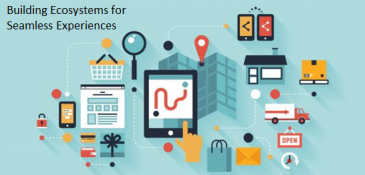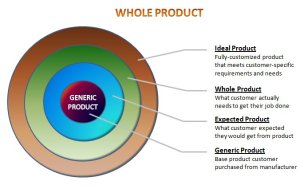
In the first post of this series, Paul Hobcraft framed what we believe is an exceptionally important issue: innovation doesn’t really work the way we’d like it to. Far too often, innovation creates incremental, discrete products that don’t seem to drive customer engagement, don’t create disruption in the marketplace and don’t drive a significant amount of revenue or profit.
There are many reasons we could point to – poor understanding of customer needs, risk and uncertainty constraining innovation teams, lack of innovation process and training on the part of the innovation teams, little to no funding, and so on. These are common challenges that innovation teams face.
However, we believe that many innovation challenges stem not from a lack of internal knowledge or capability, but from misunderstanding the customer and his or her expectations about experiences. Customers today expect seamless experiences, supported, maintained and enabled by complex ecosystems of products, services, business models, channels, information, and complementary products and services. Customers aren’t interested or willing to acquire disparate products and services and integrate them. Increasingly customers prefer to acquire seamless experiences, and this expectation will dramatically change how companies innovate.
The problem of narrow focus
For decades, companies have organized around products or services. Most companies have teams organized to develop, produce and manage products. Staffing and budgeting processes are tuned to assist in the development, production, marketing and sale of discrete products. This is an efficient organizational model, but increasingly doesn’t mirror consumers’ needs and expectations today. In the past, solving a customer’s need was more simple. When products didn’t exist, companies can provide a discrete product and the needs were filled. When incomplete or inadequate products exist companies provide a more interesting alternative. Today, when customers basic needs are filled and they are overwhelmed with product choice, they aren’t satisfied with yet another discrete product offering.
Maslow’s hierarchy explored a similar phenomenon for humans, in that we first fill basic needs, such as physiological and safety needs before filling aspirational needs. Similarly, once basic product and service needs are fulfilled, customers seek seamless experiences based on compatibility, integration, ease of use and customer experience. This means that how we innovate needs to change. There’s a fundamental mismatch between companies, which are still optimized to create discrete products, and customers who seek seamless experiences based on robust ecosystems.
Stephen Elop, who was brought in to save Nokia as its market share and profits were taking a beating from Apple, noted this trend. In a fascinating note to his colleagues now known as the “burning platform” memo, Elop said:
The battle of devices has now become a war of ecosystems. In this case it is where ecosystems include not only the hardware and software of the device, but developers, applications, location-based services, unified communications and many other things. Our competitors aren’t taking our market share with devices; they are taking our market share with an entire ecosystem. This means we’re going to have to decide how we either build, catalyze or join an ecosystem.
This memo was written in 2013, and the understanding of future market conditions is prescient. Elop recognized that Apple was winning because it had defined an ecosystem of products, services, apps and data that provided a nearly seamless experience. The iPhone is valuable to consumers, but what makes it a compelling SOLUTION and a seamless experience is the range of apps, developers and other services and capabilities. For its “ecosystem” Apple defined and built on previous experience with the iPod, and controlled a lot of the ecosystem through iTunes or other factors.
Most companies won’t be able to have as much control over an ecosystem as Apple did, but that does not excuse them from needing to understand the ecosystem they are targeting with new products, and how that ecosystem will embrace and support their discrete product, or whether, in Elop’s words, the innovators will need to “build, catalyze or join” an ecosystem.
Ecosystems and “whole products”
Discrete products typically address only a portion of a customer’s real need. Customers are often required to combine products, services, channels, information and other components to create the solution they need. Recognizing that customers leverage ecosystems, and gain value from products or services as the products and services themselves integrate to ecosystems, means that innovators can’t simply create discrete products and ignore the ecosystems those products will enter. Increasingly, understanding the ecosystem and its expectations becomes as important as understanding product requirements and features. In fact one could argue that companies should employ “Ecosystem” managers whose job it is to define the ecosystem that’s required for a complete customer solution in the same way they employ product managers to define product requirements.
This need refers back to what Geoffrey Moore, in his book Crossing the Chasm, called a “whole product”, except that now that definition is too narrow. Moore’s idea was that early adopters were willing to acquire and use relatively raw technologies or discrete devices, while the majority of the market would wait for a fully realized product supported by help manuals, customer testimonies and other supporting or enabling capabilities.

Rather than “whole product” perhaps we should call the necessary outcome a “whole ecosystem” or “whole experience”. Moore’s insight holds true today: customers want “whole” solutions or experiences, and those solutions and experiences are going to rely on products, services, information, complementary services and experiences that we may not control. As an innovator, understanding the importance of the ecosystem in providing a seamless experience, and understanding what your eventual solution will offer, and what other capabilities, services, information or experiences must be wrapped around your offer, will ensure much more receptivity when the solution is launched.
Moving from ecosystems to seamless experiences
Increasingly, customers don’t want to knit, integrate, or combine products or work to connect products and services to solve problems. Increasingly they want solutions that work out of the box, fully integrated with a fabric of existing products, services and channels. What customers want is seamless experiences, which are supported by robust ecosystems. Customers want solutions that don’t require them to worry about compatibility, solutions that don’t require a lot of configuration or knowledge on the part of the customer. They want solutions that don’t result in vendors blaming each other for failures. They don’t want to search for information, they want the solution to present relevant information. These seamless experiences are built on robust ecosystems, which is why innovators must consider them.
In some instances an innovator may discover that an ecosystem exists and there are gaps within the ecosystem he or she can fill. In other cases an innovator may discover that the discrete product or service being created requires more services, channels or experiences than can be created by the company, and therefore the innovator must build or catalyze an ecosystem in order to fully address customer needs. Ecosystems of products, services, business models, channels, partners, experiences and so on provide the total solution a customer seeks: an integrated, whole, seamless experience.
Based on this analysis the job of an innovator changes. No longer can they focus solely on discrete product requirements, because we know that a product or service is likely to provide only a portion of the expected seamless experience. Now, the innovator must define the totality of the seamless experience and then determine which components or portions his or her company can provide, which of the components or solutions that other companies or partners will provide, and work to ensure that these disparate components, services, business models and information will work seamlessly for the customer.
This means the innovator must simultaneously understand customer needs broadly, apply them narrowly to construct a new product while understanding the larger context the product or service will exist in, and attempt to weave together a range of different, potentially competitive providers to provide a solution that solves the customers problem or challenge and seems seamless and effortless to the customer.
Comments are closed.